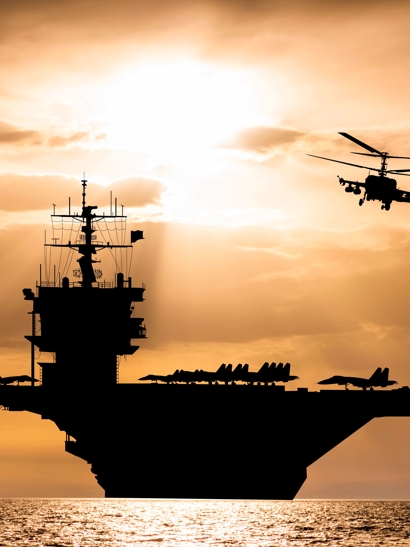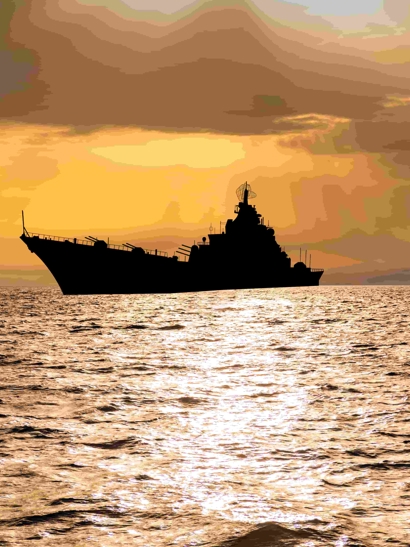
Technologies in the defence arena are developing at such a pace that the fundamental design of tomorrow’s naval vessels will be very different from those of today. For classification societies engaged in providing assurance services, design concepts involving complex new technologies, or the application of existing technologies in new applications, require a sophisticated approach to risk assessment and validation.
It’s a process that is already well underway at Lloyd’s Register. LR’s naval heritage stretches back more than 150 years, with some 400-plus naval ships being built to LR class over the last 30 years. Today, the classification society provides services to 19 navies at all stages of the naval ship lifecycle. It was the first classification society to publish a bespoke set of naval ship rules in 1999 and has many naval clients worldwide, over and above members of the so-called ‘Five Eyes’ intelligence alliance.
David Lloyd, LR’s Naval Business Director, is an ex-Royal Canadian Navy officer whose background is in marine systems and naval architecture. He says that until now, many naval vessels have been crew-intensive – for very good reason: the ships themselves are complicated, and their operational profile requires them to fulfil a wide range of missions requiring a high degree of training and competency in many areas.
Autonomous systems
With the significant advances that have been made in autonomous technology and other enabling technologies (Artificial Intelligence, sensors, digital twins, and so forth), many of the tasks undertaken by human beings can be carried out by systems that require much less human input or presence. These autonomous systems can be used to reduce the number of personnel on board a warship without reducing its mission capability, or else greatly increase the safety of personnel aboard by remotely carrying out dangerous operations.
“For example, if you take a frigate or a corvette equipped with unmanned aerial vehicles (UAVs), you have access to the same type of intelligence in many scenarios that you would have from a helicopter. So if you no longer need a helicopter, or its crew, or all the fuel onboard to support it, you gain more space and can either do much more with the same sized ship or have the same mission capability with a smaller ship.”
Lloyd highlighted mine clearance as another example. Underwater autonomous vehicles can carry out this role in place of ship’s crew, mitigating risk to potential loss of life. Similarly, in regions near the shore where ships are particularly vulnerable to attack from many forms of asymmetric threat, unmanned vehicles can provide a significant amount of ‘battlefield awareness’ in the air, surface or underwater elements.
“You just can’t get that coverage using ship’s crew in RIBs (rigid inflatable boat), and that doesn’t even consider the benefits of reducing the hazardous nature of those operations to the crew. The result is that the capabilities of smaller ships can now rival those of larger ones, or even be dramatically improved, at substantial cost savings, both at acquisition and during their in-service life. So many navies are now considering ships in the OPV and corvette size range instead of frigates – the so-called rise of the ‘light frigate’.”

“If you no longer need a helicopter, or its crew, or all the fuel onboard to support it, you gain more space and can either do much more with the same sized ship or have the same mission capability with a smaller ship.”
New design parameters
Does this have significant implications for vessel design and manning? Very definitely yes, says Lloyd. “Navies are increasingly looking at how to reduce crew numbers for many reasons – the cost of operations and, in many cases, recruiting challenges, to name a couple. But although one may have a smaller ship, fewer crew members, and an equivalent or better mission capability, there are other issues to consider.
“As a classification society, we must assure that autonomous systems and the technologies they use are safe and fit for their intended function in a marine (and combat) environment. We have therefore developed an Unmanned Marine Systems Code to help understand where the risks lie with autonomous technologies, including the ever-present threat of cyber-warfare with highly interconnected devices and systems.
Lloyd continued by revealing how additive manufacturing – also known as 3D printing – is being used to increase operational availability and extend the life of key systems onboard ships. Typically, navies go through procurement cycles fairly infrequently, so naval vessels have long lives. But 3D printing could extend the lives of such ships even further. Lloyd explains how;
“We can now digitally manufacture components on-site that are unavailable or even obsolete. You can literally create parts from scratch. 3D printing also can enable critical parts to be created in theatre; you don’t necessarily have to bring a ship back to a port or a repair yard or wait for a complex supply chain to procure a hard-to-find item, for what might be a relatively small component replacement. That raises efficiency, reduces cost and increases operational availability.”
The downside is that additive manufacturing is a very complex process and is therefore difficult to do well – and that it requires space, which is typically at a premium on a warship. But the technology is developing fast. Lloyd revealed that it is easy to envisage a versatile 3D printing system being placed in an ISO-sized container.
“So if you have a large naval auxiliary vessel, one could imagine putting a 3D printing system on board, enabling the ship to provide hard-to-access spares to other vessels in theatre without any supply chain headaches or time alongside,” he explains. “While there is not really any business case for additive manufacturing at the newbuild stage, there does appear to be a very strong case in terms of maximising in-service uptime and extending the lives of assets.”

The decarbonisation challenge
As a growing number of merchant ship operators adopt new less carbon-intense fuels such as LNG, LPG, and methanol under upcoming IMO Regulations, some governments of navies have put policies in place that will impact those navies, making them consider now what a net-zero scenario for them could look like by 2050. Lloyd explained that naval vessels are not bound by Flag state requirements or IMO Regulations and outlined some of the challenges of adopting new fuels.
For a start, new fuels must be demonstrated to have an equivalent level of safety in their use on board as existing ones – and within a military context, this is of course very challenging. Navies may be innovative, but they are not fundamentally risk-taking organisations, he points out. “New fuels must therefore be very well tried and tested before a navy will adopt them.”
There are a range of other questions too, including fuel availability and volumetric energy density. Military vessels are typically heavy fuel consumers – requiring speed and range to meet their operational commitments. A low-density fuel could well require a very large tankage volume on board to provide a vessel with adequate endurance, rendering it of limited use in meeting its intended missions in other areas due to overall space availability.
A further issue is the requirement to have ‘inter-operability’ with other navies. “In the course of a military exercise, it may be necessary for a Canadian AOR (tanker) to refuel a British frigate,” Lloyd pointed out. “There has to be compatibility across a considerable number of allied or like-minded nations’ navies.”
One potential future fuel that has not really been linked to decarbonisation and the energy transition until recently is the nuclear option. Noting that several organisations are examining small-scale nuclear reactors within the merchant shipping and offshore sectors, Lloyd said that there has been a noticeable shift in these discussions, even over the last 12 months.
“Some of the newer nuclear technologies do not rely on pressurised reactors,” he declared. “They are therefore easier to contain if something goes wrong, so they result in inherently safer designs in many respects.”
As has happened so often in the past, finding military applications that exploit cutting-edge commercial technologies is once again proving to be a catalyst in naval design and operations.








